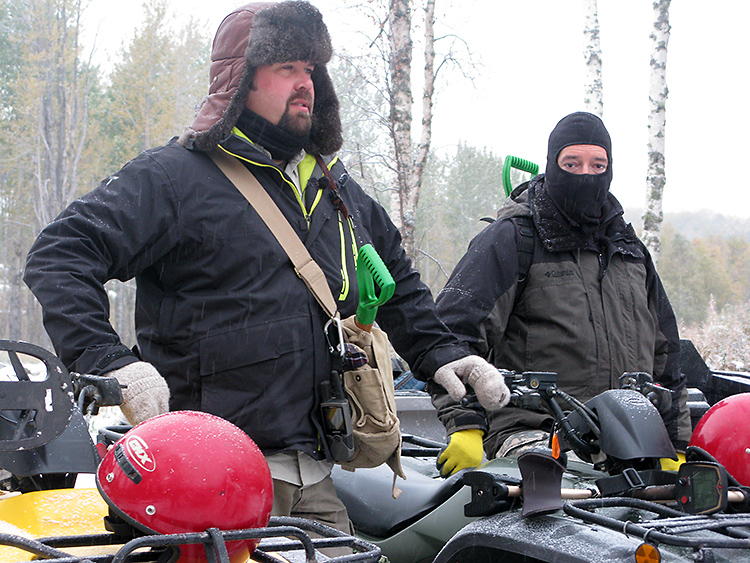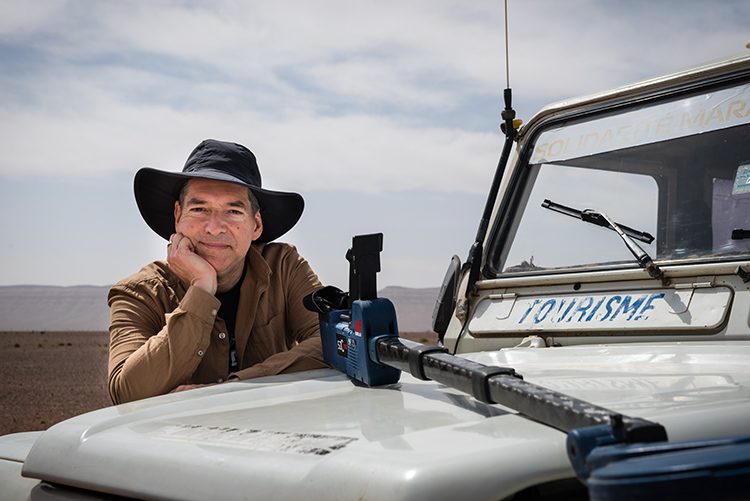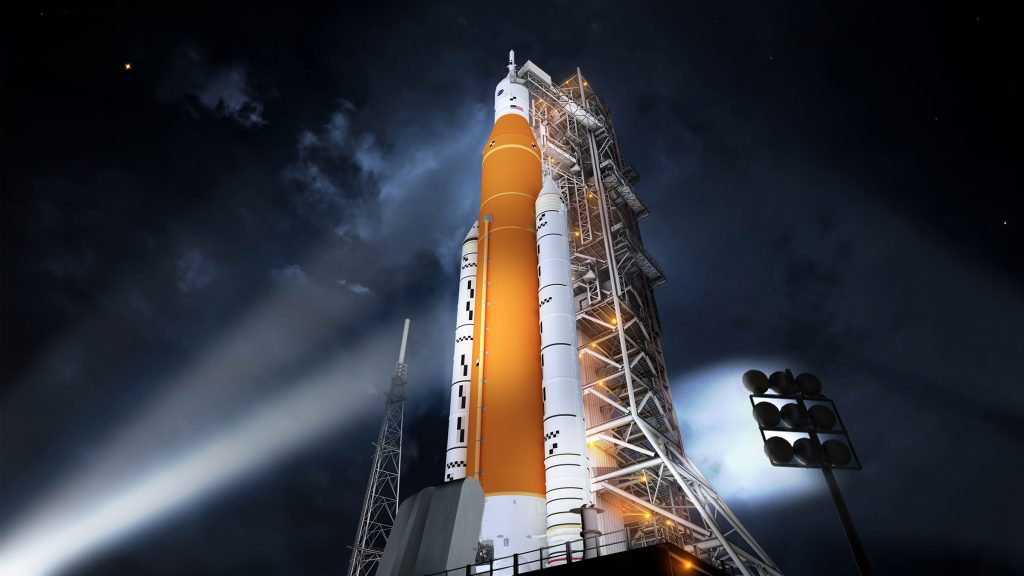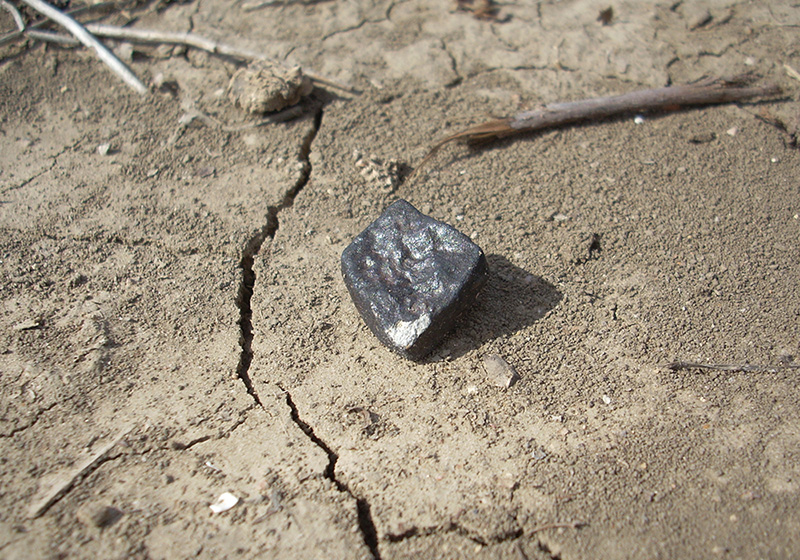
ABOUT ME
Meteorite specialist, science writer, columnist, Emmy Award-winning host of TV’s STEM Journals and Meteorite Men, film producer, adventurer, and world traveler. I sit on the Board of Governors of the National Space Society; the Board of Directors of the Astrosociology Research Institute; the Board of Directors of the Science, Arts and Space Institute; and the Advisory Board of Deep Space Industries. If you look far enough up into the night sky, I am also Asteroid 132904 ”Notkin”.
PREPARING FOR A METEORITE-HUNTING EXPEDITION
Film director Ed Podiam said: “There is no practical way to prepare for an epiphany or a catastrophe. You tell yourself you’re ready, but then it happens regardless, for better or worse, and in ignorance of your best efforts.” I feel this insight applies particularly well to meteorite-hunting because, no matter how carefully you prepare for an expedition, you can never fully and completely “expect the unexpected,” even though the great science fiction writer, Douglas Adams, offered that as a key piece of advice to galactic travelers in his masterpiece, The Hitchhiker’s Guide to the Galaxy. The experienced adventurer plans as well as he or she can but — on the day — must always be ready to adapt, evolve, reboot, or revise the plan.
After Season One of my first television series, Meteorite Men, became an unexpected hit, there ensued a lengthy behind-the-scenes discussion about how the show runner might go about scripting Season Two. There were no scripts in Season One, just a half page, or so, of notes outlining what the director hoped to accomplish in each episode. A sample concept for a proposed Season Two script read something like: “Geoff climbs to the top of the hill in the desert and digs up a meteorite. Then he calls Steve, excitedly, on the walkie-talkie.” It was never going to work because nobody — including me — knew if there was a meteorite at the top of that hill. We had to go up there and look for ourselves, in real time, with a metal detector or meteorite-savvy eyes. Fortunately, our senior producers soon realized that you cannot script a meteorite find. Our show already had a unique and authentic pacing and the producers were understanding enough to appreciate that the only way to make a real television adventure show is to let the adventure happen the way it wants to happen … and film everything that goes down.
Here is why:
Most meteorites come to our little planet by way of the Asteroid Belt, via deep and cold space. Everywhere out there is on the way to nowhere. The average journey distance for a meteorite en route to Earth is about 250,000,000 miles. And I thought it was a long way back to London.
Every meteorite that reaches the surface of our home planet has overcome seemingly impossible, unmeasurable, and wholly cosmic odds to get here. When asteroids smash into each other — out there between Jupiter and Mars — blasting pieces in all directions, those shard-like fragments could, very literally, go anywhere: straight into another asteroid, off to frigid inter-solar-system blackness to be lost forever, or annihilated by the blinding heat and crushing gravity of our own sun. Those few fragments that do, by chance, find their way to Earth encounter moist atmosphere as fast as — well — an actual rocket, and our protective blanket of oxygen and nitrogen might cause them to skip, bounce, and hurtle back out into space. If they don’t shear away but, instead, continue plowing towards Mother Earth through ever-thickening air, they may well burn up completely, or explode into minuscule pieces as a result of a devastating and near-instantaneous temperature change. Or, most likely of all, they could just drop into the oceans that cover most of our planet, and sink. Some land in sand dunes or Arctic snowfields, are swallowed by jungles, or — as in the case of one fireball we frantically investigated — have the very poor directional sense to make landfall in the middle of a top secret military testing ground, never to be seen by human eyes.

Geoff Notkin and Steve Arnold in Chile's Atacama Desert
In my life, a meteorite hunting expedition often begins with a phone call. That call is usually — but not always — from Steve Arnold — a hunter and adventurer of great talent and drive, and my indefatigable co-host on Meteorite Men. The gist of a recent call was: “Hey, Geoff! I’m headed to the Sahara to hunt meteorites. Wanna go?” As simple as that. Much later, I realized that the Sahara expedition dates would be — pretty much to the week — the twenty-first anniversary of our very first joint adventure to Chile’s Atacama Desert in the spring of 1997. I planned for that long-ago journey in much the same way that I planned this one. Though, I like to think I’ve learned a few things in the intervening decades.
Meteorites fall where they are going to fall. They pay no heed to the Equator, or Earth’s magnetic pole, or the government, or anything other than the unflinching rules of physics and gravity. Space / rock / atmosphere / boom. The odds are heavily against any meteorite making it all the way to Earth. The odds are also heavily against you, or me, or anyone finding it. The successful meteorite hunter, therefore, does everything possible to improve those casino-like odds.
If you intend to hunt in a place where meteorites have been found in the past, start by doing your research. Do thorough research. There was never a meteorite hunter who did too much research. On the other hand, most of us have glanced all-too-briefly at the existing conventional map of a new fall site and — eager to get out and get on with the hunt — thought to ourselves: “That area doesn’t look so big, I’ll figure it out when I get there.” And then, when you do get there, you realize “that area” stretches, foreboding and featureless, in every direction until sunset, or — worse — it is a mushy, swamp-sodden paradise for rattlesnakes and cottonmouths (this precise thing has happened to me). Perhaps, upon arrival, you realize the likely fall site is awash with densely-packed trees or corn stalks that wouldn’t consider allowing you to swing a detector among them, or maybe your favored ground is decorated with “NO TRESPASSING” signs (in New Mexico, while hunting the Glorieta Mountain strewnfield, I once saw such a sign that included the text: “SURVIVORS WILL BE PROSECUTED.”) Whenever possible, know where you are going before you get there, and pack accordingly. If you’re going to the Arctic (as I have, repeatedly), you may need snow gear. If you’re going deep into the poison-ivy rich swamps of Alabama in the summer (as I have, fortunately only once), waders and snake gaiters will be far more useful.

The Meteorite Men off-road it to Whitecourt Crater in the Canadian winter
If a meteorite was found at the site you headed to, try and determine precisely where and under what circumstances the discovery was made. Begin your search there and work outwards. Meteorites often fall in clusters, so there may be others nearby. Was the initial find deeply buried and discovered with the help of a detector, or was it lying on the surface? The age of the fall and the type of meteorite will dictate your search methods.
Be aware that different countries have varying regulations about meteorite ownership and export, so do your homework before you head overseas. You cannot, for example, remove meteorites from Canada or Australia without explicit government permission and paperwork.
Take everything you need, but try to make sure you need everything you take. This is tricky for me, because I like to have every conceivable bit of gear I might want, but I also like to travel light. Those two concepts don’t mix well together, so I have to play Give and Take as I prepare for each expedition. Many of the things I pack in (energy bars, soluble vitamins, trail mix, etc.), won’t pack out with me because they are consumed during the expedition, hopefully making room in your bags for finds and souvenirs. Wondering what to do with those sneakers and socks that are nearly worn out? They make great expedition fodder. Wear them around camp, or on travel days, and toss them at the end of your final day in the field. If you’re operating in an underprivileged country, you may find a grateful person who will enthusiastically give a good home to the used boots, cooking pan, or old sleeping bag that you don’t want to take home. That way, if you fall in love with a camel blanket or a fez, you’ll have room in your bag to bring them back as gifts for your significant other. Or your cat (my cat has blankets from Lapland, Australia, and my favorite market in Marrakech).
The only thing better than traveling light is discovering, when you really need it, that you did bring the spare battery pack. Learning what to take, and how much of it, are acquired skills. These are some of the indispensables the serious hunter will almost always need:
GOOD HIKING BOOTS
You only get two feet and they are going to carry you everywhere you need to go en route to making your first, or next, meteorite find. My friend Mike Miller, an innovative and determined meteorite hunter, once stated the obvious when we were out in the field: “You have to walk over a meteorite before you can find it.” But sometimes obvious advice is the best advice.
Take care of your feet so they can walk over that meteorite for you. Put them inside good, sturdy, lightweight, comfy hiking boots. The comfy part is very important. If your feet aren’t happy, they won’t do a good job of porting you around the strewnfield for eight or sixteen hours a day (depending on your level of gusto). For the serious hunter, sneakers will not cut it during the long haul, especially in rough terrain. Socks are important too. On long or arduous hunts and hikes I wear thin liner socks underneath larger cotton socks. The liners wick away moisture, help prevent blisters, and also provide extra cushioning.
DAY PACK OR UTILITY BELT
Choose a lightweight day pack when doing actual hunting and always take it with you. Even on a short hike. If you make a find, or get lost, or both, a “short walk” can very quickly turn into the long hike you were not prepared for. Only put essentials in your pack. Leave your flip flops and your bedtime reading in the tent or vehicle. Some of us have been hefting packs in and out of craters and up and down mountain ranges for years or decades. Some people’s backs may have started complaining about the abuse. Osprey makes a terrific utility belt that comes with a one-liter water bottle in each of two side pockets, along with plenty of zippered pockets for other necessities. Tired back? Let your hips take the brunt for a change.

METAL DETECTOR / MAGNET CANE
If you are looking for buried meteorites you will need a good metal detector. Different detectors are better at finding different types of meteorites. Do you homework or ask me. Aerolite Meteorites, Inc. is an authorized Minelab metal detector dealer with decades of meteorite-hunting expertise and we will be glad to advise you.
We take magnet canes into the field for a reason. Almost all meteorites contain iron and will stick to a magnet. There are, however, a whole lot of rocks out there that look like meteorites, but aren’t. Using a magnet cane prevents you from bending over to pick up rocks one thousand times a day. If that doesn’t sound like such a big deal, try picking up a thousand rocks in one day, while discovering that none of them are meteorites.
GPS
When searching in known strewnfields, I log every find. That helps me understand the fall pattern of meteorites and may give me clues about the locations of other, undiscovered pieces. GPS data can be very useful to meteorite researchers who are building strewnfield maps, and a GPS can also save your life. Eager to start a desert hunt, I once took off in such a hurry that I lost my bearings. It is very easy, especially in tundra or flat desert, to forget where you parked the truck. Before you head out into the field, GPS your vehicle or campsite, so you can find your way home when you are tired and it’s getting dark.
WATER AND NOURISHMENT
Most of us know that you’re supposed to drink two liters of water a day and that’s just under normal conditions. If you’re hiking around, swinging a detector, carrying a pack, and digging in the dirt, your body needs more than that. Carry extra water. Use a Camelback or multiple canteens. I never leave the truck with less than 1.5 liters on my person.
The excitement and exertion of meteorite hunting burns a lot of calories. Take energy bars or trail mix in your pack with you. When you get hungry, miles from base camp, you’ll be glad you have them. For breakfast and dinner try to eat real food. You need energy in the field, so find a way to mix in fresh fruit, greens, and protein when you can. Crackers and sandwiches are not effective fuel for successful adventurers. I pack two energy bars, one powdered vitamin pack, and one electrolyte pack for each day I expect to spend in the field. Pour the vitamins and electrolytes into your water bottle. They taste good and ensure you get the minerals and vitamins you need.
FIRST AID AND SAFETY
I always keep a quality, folding camping knife on my belt and I carry a small first aid kit with me if I’m hunting alone or far from base. And we keep more robust first aid kits in the field vehicles. My friends who have skin cancer wish they had used more sunscreen when they were younger. Wearing a decent, wide-brimmed hat helps prevent that, and sunstroke, and also makes you look a bit like Indiana Jones, which is never a bad thing. If weather conditions might change during your field days, put a small poncho or emergency blanket in your pack. Camping gear can be very hi-tech and you can easily find examples of each that only weigh a few ounces.
In some instances, such as traveling in the Atacama Desert or the Australian Outback, we’ve taken medics and / or survival guides with us, because we were so far from civilization that an emergency evac — even by helicopter or flying doctor — wasn’t an option. It was money well spent. Hazards vary by country and season and it’s extremely valuable to have a local expert point out what’s dangerous and what isn’t.
INSECTS
Some insects are an annoyance; others are dangerous. I don’t ever wear open-toed shoes in the field, and I rarely wear shorts because both increase your exposure to bites and stings. Keep a small bottle of insect repellent in your pack and you should have antiseptic wipes in your first aid kits. I also carry a folded mosquito / fly net that’s not much bigger than a wine cork. It fits into a tiny pocket on my belt pack.
INSURANCE AND EVACS
If you are going way out there into the hostile world, as I sometimes do, you may consider investing in premium insurance services. Companies like Global Rescue offer medical and military evacs, should you find yourself in a really dicey situation. In remote areas, you are not going to have conventional cell service, so I recommend renting a sat phone for serious expeditions. They are expensive to rent and to use ($2 per minute is typical, plus rental fee for the unit), but that $2 call could save your life, or the life of a team member.
PACKING
If you are flying to your destination, be aware that most airlines charge for each checked bag and the typical weight limit is about 50 lbs per bag. Put heavy and valuable items like cameras and laptops in your carry-on, as most airlines don’t weigh them, and you don’t want that stuff thrown around by baggage handlers anyway. I invested in a small, portable hand scale that tells me exactly how much my bags weigh. It’s handy to know that before you get to the airport. On a major expedition I travel with matching heavy-duty rolling bags. I split up the big stuff: my folded-down Minelab SDC 2300 metal detector loves to travel and it goes happily in one; my hiking boots and magnet cane in the other.
We all need clothes, so wrap your detector in a field jacket or jeans for added protection. If you are driving to the hunt site, your detectors still need to be treated with care and respect. Expert meteorite hunter, Twink Monrad, is also a seamstress and she made snappy cloth detector bags for herself and her hunting partner, the late Jim Kriegh.
We use powerful rare earth magnets in meteorite hunting and they’ll be glad to wipe your credit card, hotel card key, or iPod, so I bundle one in a wool sock and put it in my hiking boot. When driving, magnets are very happy to live clamped to the bed of your truck until you need them.
FUN AND MEMORIES
Meteorite hunting is not all about the finds. It’s also about the journeys we embark upon and the friends we go with, or make along the way. Take a small camera or smart phone with you. Later, you’ll look back on adventure photos with delight. Don’t forget to pause for a moment and take an in situ photo of your find. Your friends will be impressed by when you get home and they will say: “You found that!?” You might take a little notebook and keep a daily trip journal. I always carry a thick paperback book with me too, as you never know when you might have to occupy and hour, or a day, while a tire is being changed or an airplane is being refueled.
Above all, remember that no matter how much you plan, nothing ever turns out quite the way you expected. Be nimble, like the snake who glides between boulders. Be ready to adapt to changing situations and try to appreciate the opportunities you have been given. Meteorite hunting is not for everyone, but every hunt is an adventure.
The greatest meteorite hunters know that every good find happens because of research, skill, knowledge, determination, and chance. We learned in Meteorite Men that the best adventures are always the unscripted ones and, in his memoir, Travels With Charley, John Steinbeck observed: “We find after years of struggle that we do not take a trip; a trip takes us.”
May you be taken by a good one.
To learn more, read my book, Meteorite Hunting: How to Find Treasure from Space, now available as an ebook.
FOLLOW US
RECENT BLOG POSTS
WANT TO KNOW MORE ABOUT METEORITES?
Watch our FREE Meteorite Minute series on YouTube!








